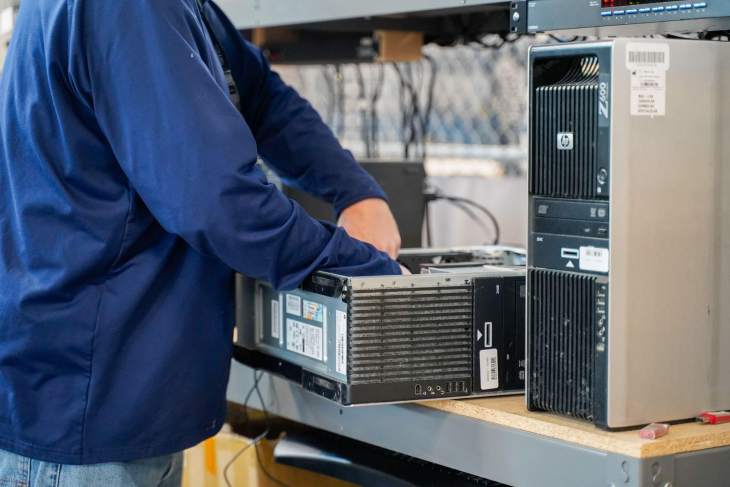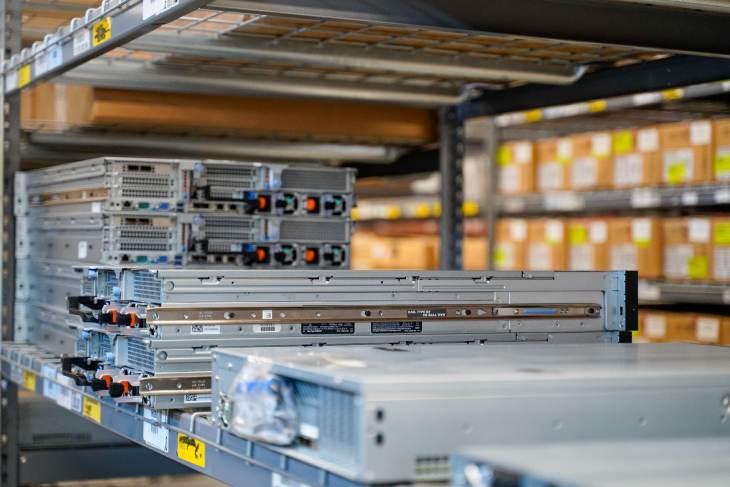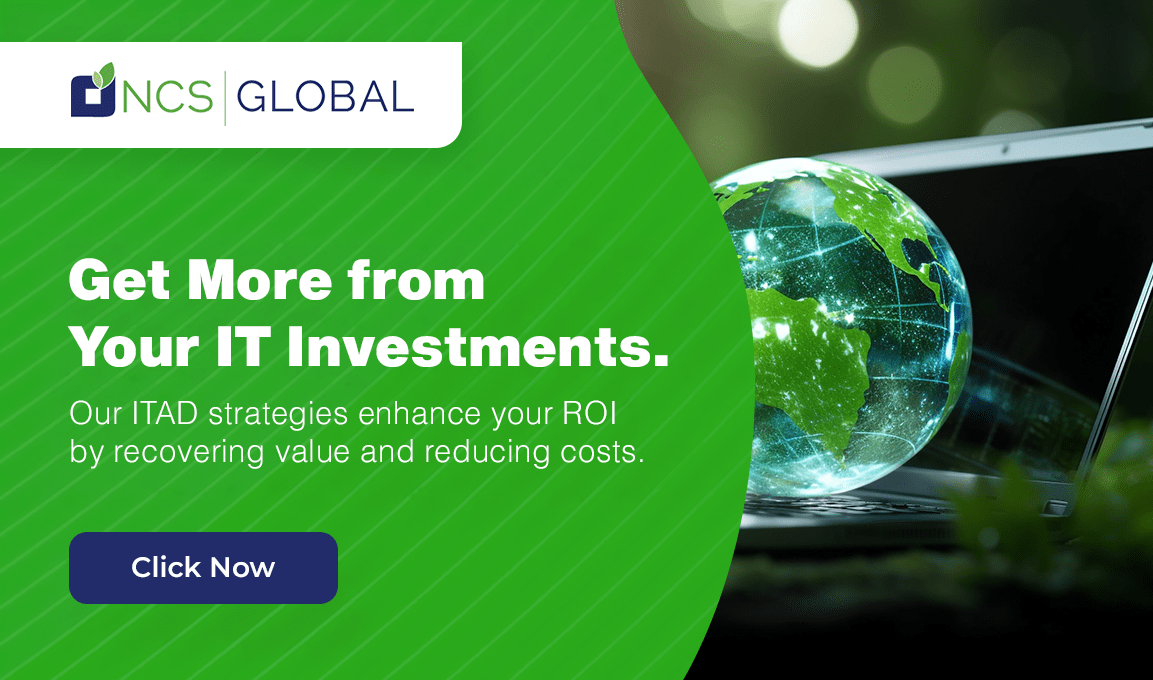The Financial Benefits of Implementing an IT Asset Recovery Strategy

IT asset recovery services address a range of critical needs for today’s businesses, improving sustainability and security while returning scarce dollars to the bottom line. By reclaiming and repurposing retired or unused IT assets such as computers, servers, and networking equipment, IT asset recovery optimizes the lifespan of IT assets, mitigates the environmental impact of electronic waste, assures data security, and maximizes the salvage value of unwanted IT equipment for your organization.
By reselling or repurposing IT equipment, companies can recoup a portion of their initial investment, turning what would otherwise be a sunken cost into a revenue stream that offsets the cost of acquiring and managing IT assets. Secure IT asset recovery services also reduce storage and disposal costs, and they reduce the risk of legal and financial penalties by ensuring compliance with data privacy and security regulations.

Understanding IT Asset Recovery
What is IT asset recovery? It’s the process of reclaiming and repurposing IT assets that are no longer in active use. This can include desktops, laptops, servers, storage devices, networking equipment, and peripherals, for example.
Companies that provide IT asset recovery services perform a series of functions; they identify, inventory, and evaluate unwanted equipment, securely destroy any remaining data, then prepare the items for resale, often repairing or refurbishing them as part of this process. Items that are not suitable for resale are recycled or disposed of in a safe manner. The ultimate goal is to maximize the value recovered from these assets while ensuring environmental responsibility and compliance with data security requirements.
IT asset recovery plays an important role within the broader context of IT lifecycle management. The latter includes planning, purchasing, deployment, maintenance, and eventual disposal of IT assets. Integrating asset recovery into the lifecycle management process ensures that organizations can efficiently manage IT resources for optimal value. By planning for asset recovery in advance, companies can make more informed purchasing decisions, anticipate future disposal needs, and establish processes that facilitate the smooth transition of assets through their lifecycle stages.
During the deployment and maintenance phases, a clear IT asset recovery strategy provides for better tracking and management of IT assets, ensuring that they are used effectively and retired at the appropriate time. When the time comes to decommission equipment, a clearly defined recovery process ensures that assets are securely and responsibly handled, minimizing the risks associated with data breaches and environmental damage.
The financial returns generated through the resale or recycling of retired assets can be reinvested into new technology, supporting continuous innovation and keeping the organization’s IT infrastructure up to date. By considering IT asset recovery as part of the larger lifecycle management process, IT leaders can more accurately predict their financial needs.
Maximizing Returns on IT Investments
To recover value from retired or surplus assets, companies that offer IT asset recovery services will refurbish and resell functional equipment, extending its life and recouping investment costs. Component harvesting collects valuable parts from non-functional devices to be reused or sold separately. Responsible recycling of materials such as metals and plastics also has the potential to generate revenue. Partnering with a reputable IT asset disposition (ITAD) company can enhance value recovery by ensuring secure data destruction, compliance with regulations, and efficient logistics.
Asset recovery significantly reduces your total cost of ownership by offsetting expenses related to new equipment purchases, storage, and disposal, while generating revenue from reselling or recycling assets. This results in better financial management and resource allocation. Additionally, asset recovery enhances the ROI of your IT spend by turning retired assets into immediate revenue. The funds recovered can be reinvested in new technology, driving innovation and maintaining competitive advantage, while also ensuring data security and regulatory compliance.
Cost Savings through Efficient Asset Recovery
Effective IT asset recovery significantly reduces expenses associated with the storage, maintenance, and disposal of unused assets. By reclaiming and repurposing retired IT equipment, organizations can free up valuable storage space and avoid the costs of maintaining and securing idle assets. Additionally, proper disposal through recycling or resale eliminates the expenses related to disposing of electronic waste, ensuring compliance with environmental regulations and avoiding potential fines. This streamlined process minimizes overhead costs and maximizes resource efficiency.
Asset recovery plays a vital role in optimizing IT budget allocation by turning retired equipment into revenue-generating assets. The funds generated from reselling or recycling unused IT assets can be reinvested into new technology, supporting continuous innovation and infrastructure upgrades. This approach ensures that IT budgets are used more effectively, reducing the need for additional capital expenditure. By incorporating asset recovery into their financial planning, organizations can enhance their return on investment and ensure more strategic allocation of IT resources, ultimately supporting long-term business growth and sustainability.

Revenue Generation from Resale and Recycling
By reselling refurbished IT assets, companies can create a new stream of revenue. Functional equipment that has been cleaned, repaired, and upgraded can be sold in secondary markets, allowing organizations to recoup a portion of their initial investment. This not only extends the lifespan of the assets but also provides affordable technology options for smaller businesses or consumers, creating a win-win situation. By tapping into this resale market, companies can turn retired equipment into a valuable revenue stream, supporting financial sustainability and reducing electronic waste.
Recycling and material recovery from unused IT assets yield considerable financial benefits. Components such as metals, plastics, and rare earth elements can be extracted and sold to manufacturers, generating additional revenue. This process not only mitigates the environmental impact of electronic waste but also offsets the costs associated with disposal. By efficiently reclaiming valuable materials, organizations can enhance their ROI and contribute to the circular economy.
Best Practices for Implementing an IT Asset Recovery Strategy
To develop and execute an effective asset recovery plan, start by conducting a thorough inventory of all IT assets to identify those that are no longer in use or nearing the end of their lifecycle. Establish clear policies and procedures for asset collection, data sanitization, and refurbishment or recycling. Partner with a reputable ITAD company to leverage their expertise. Regularly review and update your IT asset recovery plan to adapt to ensure that it remains aligned with organizational goals and sustainability initiatives.
Compliance with data protection regulations is critical. An experienced ITAD service provider will already have stringent data destruction processes in place to safeguard sensitive information. Choose an ITAD partner who adheres to industry standards and certifications, and stay informed about relevant laws and regulations to avoid legal penalties. By prioritizing security and sustainability, organizations can mitigate risks and demonstrate their commitment to ethical and responsible asset management.
A robust IT asset recovery strategy not only enhances financial performance by recouping investment costs and generating revenue but also supports sustainability and compliance goals. By effectively managing retired IT assets, organizations can optimize their IT lifecycle, reduce costs, and ensure secure and environmentally responsible practices, ultimately driving long-term business growth and innovation.
Interested in reaping financial benefits from your unwanted equipment? Contact an expert at NCS Global today to Get more from your IT investments.
